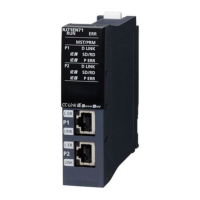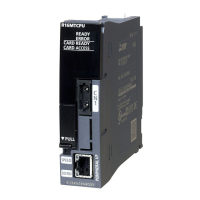10 TROUBLESHOOTING
10.4 Troubleshooting by Symptom
213
10
When transient transmission cannot be performed
The following lists the actions to be taken if transient transmission cannot be performed with the target station, and the
engineering tool cannot perform monitoring.
Check item Action
Is the D LINK LED of the FX5-CCLGN-MS flashing or turned on? Perform troubleshooting to be performed when the D LINK
LED turns off. ( Page 196 When the D LINK LED turns off
or is flashing)
Is the data link status of the target station normal? In the CC-Link IE TSN/CC-Link IE Field diagnostics, identify
the cause of the error and take action. ( Page 201
Checking the Network Status)
Are the following data set correctly when a module FB or dedicated instruction is executed?
• Target station CPU type
• Target network number
• Target station number
Correct the section where the module FB or dedicated
instruction is executed in the program.
Is the network number duplicated on the network? Correct the parameter so that duplication does not occur
among network numbers.
Are multiple link dedicated instructions with the same channel setting executed
simultaneously?
• Set a different channel to each instruction.
• Shift the execution timing of the link dedicated instructions.
Does the IP filter setting mistakenly block communications from the IP address of another
station?
Change the IP filter setting parameter to allow communication
for the IP address of another station.
The connection device
information of the master
station is set to "CC-Link IE
TSN Class B Only".
Are CC-Link IE TSN Class A devices connected? Disconnect the CC-Link IE TSN Class A devices.
Is an industrial switch (for CC-Link IE TSN Class A)
connected?
Remove the industrial switch (for CC-Link IE TSN Class A) or
connect the industrial switch (for CC-Link IE TSN Class B).
The connection device
information of the master
station is set to "Mixture of
CC-Link IE TSN Class B/A or
CC-Link IE TSN Class A
Only".
For firmware version "1.002" or earlier
Are nine or more CC-Link IE TSN Class B devices and
industrial switches connected in total to each port of the
master station in the transmission path from the master
station to the CC-Link IE TSN Class B device of the end?
Check the connected devices and reduce the number of CC-
Link IE TSN Class B devices and industrial switches to eight
or less in total for each port of the master station in the
transmission path from the master station to the CC-Link IE
TSN Class B device of the end.
Is any CC-Link IE TSN Class B device other than the master
station connected in a star topology via an industrial switch
(for CC-Link IE TSN Class A)?
Other than the master station, do not connect CC-Link IE TSN
Class B devices to an industrial switch (for CC-Link IE TSN
Class A) in star topology. Alternatively, connect CC-Link IE
TSN Class B devices to an industrial switch (for CC-Link IE
TSN Class B).
Is an industrial switch (for CC-Link IE TSN Class A)
connected between the master station and CC-Link IE TSN
Class B devices?
Check the connected device and connect the master station
to CC-Link IE TSN Class B devices in line topology instead of
using an industrial switch (for CC-Link IE TSN Class A).
Check the connected device and connect the master station
with CC-Link IE TSN Class B devices via an industrial switch
(for CC-Link IE TSN Class B).
For firmware version "1.002" or earlier
In multicast mode, is the CC-Link IE TSN Class A remote
station connected to the master station?
• Connect the CC-Link IE TSN Class A remote station to a
local station or remote station supporting the multicast filter.
• Set unicast mode.
In multicast mode, is the CC-Link IE TSN Class A remote
station connected to a local station or remote station that does
not support the multicast filter?
• Connect the CC-Link IE TSN Class A remote station to a
local station or remote station supporting the multicast filter.
• Set unicast mode.
In multicast mode, are a local station and a CC-Link IE TSN
Class A remote station connected on the end side using an
industrial switch?
• Configure settings with the industrial switch so that the
multicast frame (with multicast MAC address
09:00:70:00:10:02 and 09:00:70:00:10:05) will not be
transferred to the port of the CC-Link IE TSN Class A
remote station.
• Check the connected device and do not enable a local
station and a CC-Link IE TSN Class A remote station to
connect on the end side via the industrial switch.
• Set unicast mode.
Is an Ethernet device connected to a place other than the end
of the network?
Check the connected device and connect the Ethernet device
at the end of the network.
Does the connected industrial switch support the CC-Link IE
TSN Class used?
Use the industrial switch that supports "CC-Link IE TSN Class
Setting" set to the master station.
(For the supported models and usage methods, refer to the
CLPA website (www.cc-link.org).

